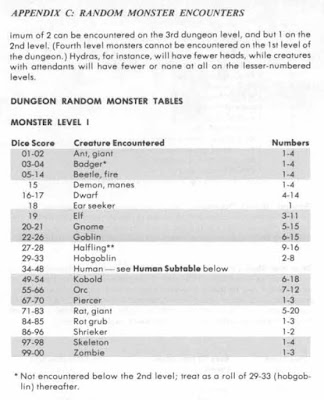While working on keying the recently-redesigned and -expanded dungeon level 2 of my version of Castle Greyhawk, I discovered that many monsters from the 1977 Monster Manual were not, in fact, represented in the Dungeon Masters Guide's Appendix C's Dungeon Random Monster Tables, which list dungeon monster encounters by Monster Level:
 |
| DMG Appendix C - Dungeon Random Monster Tables - Monster Level |
Since I use the DMG Appendix C tables to help populate run-of-the-mill dungeon encounters, using only the Appendix C tables would preclude certain monsters/types of monsters from showing up all, without some tinkering.
The analysis of these tables (as well as those that appear in the Fiend Folio and the Monster Manual II) reveals that the following noteworthy---to my eye, anyway---MM monsters are missing from the standard dungeon encounter tables by monster level:
- anhkheg
- bulette
- giant crab (despite appearing in the Black Reservoir level of Castle Greyhawk)
- giant crayfish (despite appearing T1 Village of Hommlet's Moathouse dungeon)
- crocodile (despite appearing in the Magician's Ring level of Castle Greyhawk as well as in the OD&D tables)
- dinosaur (any)
- dragonne
- dragon turtle (a primary antagonist in my own version of the Black Reservoir!)
- harpy
- homunculus
- ixitxachitl
- larva
- lizard man
- peryton
- pseudo-dragon
- giant scorpion (despite appearing in the original Castle Greyhawk)
- sphinx (any)
- giant wasp
- water weird
The above is not an all-inclusive list, and this is not to imply that these monsters don't appear in Appendix C at all, merely that they're not present in the Level I to Level X tables listed by monster level for use as random dungeon encounters. (Also noteworthy: both the nycadaemon and mezzodaemon from D3 Vault of the Drow appear in the tables, too, although drow do not, nor do other new creatures introduced with TSR's new modules).
In fact, several classes of monsters were largely absent from the dungeon-specific encounter tables, some of which were quite surprising (and some of which made some sense, of course). Taken as a whole, the following types of monsters do not appear in the Appendix C tables by Monster Level (again, for random determination of dungeon encounters):
- animals (normal and giant)
- aquatics
- avians
- faeries
- pre-historic beasts
- wilderness-only creatures (including those from extreme environs)
The lack of axe beaks, tyrannosaurus rex, giant eagles, ixitxachitl, leprechauns, mastodons, tigers, treants, unicorns, whales, and yeti makes sense in many cases---after all, how often are you DMing a mega-dungeon beneath a Castle in the Unseelie Court, set in Pellucidar, or in the frozen north?---so excluding them from standard dungeon environments makes perfect sense at the baseline level.
Several of the missing classic monsters were later added to the updated tables published in the Fiend Folio and MM2, including the anhkheg, bulette, lizard man, and giant scorpion, which helps to insure that such fan-favorite monsters are more-easily encountered in our mega-dungeons.
I do wonder why some these monsters are absent from the tables, and speculate somewhat on possible causes as follows:
- A simple editorial oversight? This seems less likely to me since the MM was published at least a year in advance of the DMG, and would have been readily available as reference.
- Some of the more-recently created monsters may have been excluded from the first drafts of the DMG tables, or perhaps not have been top-of-mind for the DMG team---the water weird, for example, is mentioned in the Preface of the MM as the creation of Ernie Gygax (and was first published in the 1976 tourney Lost Caverns of Tsojconth), and Erol Otus' remorhaz and anhkheg (from The Dragon #2 in August 1976 and #5 in March 1977, respectively); other relatively-recently created creatures like the beholder and the demons and devils from Eldritch Wizardry (April 1976) do appear in the tables, so perhaps this does fall back on editorial oversight?
- Perhaps most early mega-dungeon designs didn't include the aquatic, avian, etc. classes of creatures as part of their standard dungeon encounters' repertoire? This also seems unlikely, because Rob Kuntz and Gary Gygax have both discussed the need for larger rooms for large, flying creatures in the deeper levels of Castle Greyhawk, so perhaps the world will never know....
Happy gaming!
Allan.
At a glance, the lists sound like wilderness encounters for wilderness adventures. I would add Water Weird to my dungeon tables though, a handful of others too depending on the origin of the dungeon.
ReplyDeleteI believe it's actually the DM's responsibility to roll up encounter tables for each region, and of course track them, whether the region is a dungeon level or a desert. So I use an environment/habitat stat as in 2e for all creatures, though not their particular choices.
Excellent work Grodog. If I may, a similar analysis of monsters in the monster by terrain type charts would not be amiss. I'm fairly certain you would find a number of anomalies there as well - particularly as the MM does not explicitly denote terrain biomes for monsters and the only method I'm aware of for determining either climate or terrain for those monsters is by cross-referencing with the DMG encounter tables. Carry on!
ReplyDelete@howandwhy99: Agreed completely. I create my own WM tables for my of my levels, but I still use the monsters by level tables when populating encounters randomly.
ReplyDelete@Kellri: My sense is that that MM2 tables do a decent job of listing wilderness monsters by terrain, but I've not scratched deeper than the surface on that analysis. Definitely something to note for the tables in Dangerous Dungeons!
Suposed to be RAW these wilddoes are wilderness monsters.
ReplyDelete